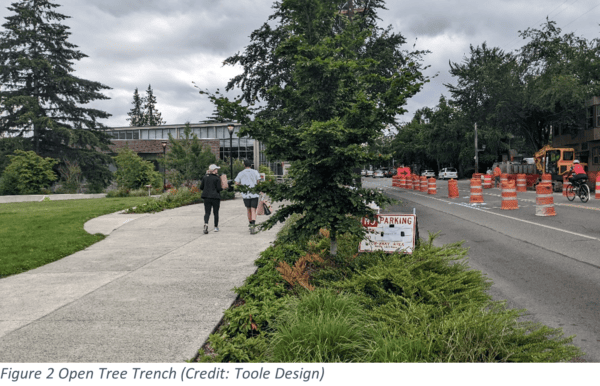Julie Shapiro, PLA, and Teresa Damaske, PLA
Trees provide many benefits in the urban environment, including:
- cooling (reducing the heat island effect)
- improving air quality
- reducing stormwater runoff
- supporting mental health
- providing wildlife habitat
- beautifying streetscapes
Our streets and transportation networks benefit from trees as they support the safety and comfort of people. Trees provide separation from the roadway and encourage drivers to slow down and pay more attention to their surroundings for people walking, rolling, biking, waiting for transit, resting, recreating and socializing.
Street trees provide shade and cooling to sidewalks, bikeways, transit stops and stations, and make these spaces more accessible, comfortable, and appealing for a wide range of users.
But there is almost always competition for limited space in our public rights-of-way. Trees are often not prioritized, their value is not fully understood, and they are not given the resources they need to thrive, achieve maturity, and provide their full range of benefits. Often, trees are not replanted in locations when they die or are removed. As a result, the tree canopy coverage in most urban areas is being reduced each year, and more steps must be taken to reverse this trend
Understanding a Tree’s Essential Needs
When planning for new trees or seeking to preserve existing trees, it is critical to understand the structure, function, and needs of the root system. The fine, delicate roots that absorb water and nutrients are located in the upper 12 to 18 inches of soil, meaning that impacts to the soil surface in the root zone can seriously affect the tree’s overall health. Compaction from foot traffic, water competition from turfgrass, and changes to soil chemistry from salts or fertilizers are all common causes of damage to these sensitive and essential roots.

Tree root system explained in detail.
Contrary to the popular belief that the form of the root system mirrors the form of the canopy, roots typically grow well beyond the tree’s drip line or edge of the canopy. The form of the tree and its extensive, relatively shallow root system has been likened to a wine glass on a dinner plate.
Given the form of the root system and the high sensitivity of the absorbing roots, it becomes abundantly clear how challenging urban conditions can be for trees. From the typically inadequate soil volumes allotted, to the mechanical and chemical hazards of daily life on a city street, to the damage incurred on construction sites with insufficient tree protection, urban trees face immense threats in both the long and short term.
The following chart summarizes trees’ essential needs and common threats to meeting these needs in an urban environment.
Essential Tree Needs and Typical Threats
| Essential Need | Threat |
|---|---|
| Oxygen to root system | Soil compaction (#1 cause of tree death), soil covering with impermeable material, trenching, cutting, or filling, operating heavy machinery in CRZ |
| Water to root system | Soil compaction, covering of soil with impermeable material, cutting and filling in root zone |
| Drainage in root zone | Soil compaction, changes to grading, and water movement |
| Protection of active trunk layers/tissues and fluid circulation | Mechanical injury that breaks bark or roots (digging/trenching in root zone, snowplow damage, locking bikes to trees, improper pruning, etc.) |
| Tolerable soil chemical composition and pH | Pollution (from construction materials, imported fill, road salt, dog urine, etc.) |
| Sufficient amounts of plants/available essential elements | Removal of organic material (i.e., leaf litter), soil pH, and temperature |
Tree Assessment and Tree Protection During Construction
During a project’s design phase, ensure the proposal meets local requirements for tree preservation and replacement. A certified arborist should assess trees that may be impacted by construction to determine the feasibility and value of preservation vs. replacement. An arborist or landscape architect can also help adjust the design to reduce impacts on trees, such as shifting the edge of pavement or curb away from a tree or modifying the grading plan.
Tree protection measures should be thoroughly described in the construction plans and specifications and installed before the start of construction. During construction, exposed tree roots should be covered and kept moist until final backfill and soil are placed. A pre-construction site walk with the contractor, arborist/landscape architect, and owner’s representative/engineer is an ideal time to review tree protection requirements and ensure trees will be adequately protected on site.
Designing for New Trees
Designing for new trees offers an opportunity to establish site conditions that will support the trees’ health and longevity. Providing a sufficient volume of high-quality soil is the first step in this process, although proper planting and selecting appropriate species are also important.

Soil volume can be provided with an open trench system or expanded tree pit. If site conditions make an open planting area infeasible, there are ways to provide large soil volumes below pavement. Structural soils, soil cells, and other suspended pavement systems may be considered to balance the physiological needs of trees with program and circulation requirements of urban sites.
An APWA toolbox that goes into more detail on protecting and enhancing our urban forests is available for download in the APWA Resource Center. The toolbox provides information on tree preservation and protection, design considerations for new trees, and the benefits of including trees in asset management systems.
Publish Date
March 21, 2022
Category
Parks, Grounds and Forestry
News Type
Education News
Related Posts
Sorry, we couldn't find any posts. Please try a different search.